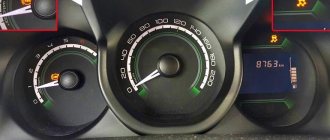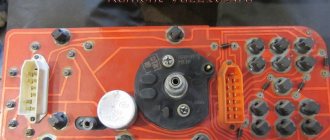In this section you will find many photos of Tuning the VAZ 2110. Tuning the interior, engine, as well as external tuning of the VAZ car. Here you will find photos of both tuned and classic VAZ 2110 cars, as well as photos of cars and girls, demotivators on the topic of VAZ cars and much more.
At the time it entered the market, the Eight was considered a truly revolutionary model among the entire model line of the Volga concern. It was this front-wheel drive car that was able to set new standards in design and driving performance for Soviet motorists. However, time passed, and the car began to become obsolete. In Togliatti they thought about creating a more progressive model and it soon appeared.
The history of the creation of the VAZ 2110 begins in 1985. From this moment on, engineers of the Togliatti Automobile Plant begin developing entire series of projects and mock-ups of the future model.
The creators were faced with the task of creating a second-generation front-wheel drive car, which would become the ideological successor to the Samara family, and at the same time, in terms of prestige, could become a level higher than the “classic” that was representative at that time. Moreover, it was planned to introduce a number of innovations into the series, the embodiment of which would be “Ten”.
Work has been carried out on the body for a long time to optimize the aerodynamic drag coefficient. Since the creation of the project and its implementation into reality, the Lada 2110 has undergone many changes in appearance, but ultimately the car entered the assembly line with a streamlined body shape.
The aerodynamic drag indicator was 0.3 units. Such figures were achieved not least due to the fact that the aerodynamics were refined by domestic engineers in collaboration with Porsche specialists.
The premiere of the VAZ 2110 took place in 1993 as part of an exhibition in Moscow. In the same year, the Russian sedan made its debut in Paris. It should be noted that the public greeted the new product very favorably, because its design at that time was quite modern and attractive. But the technical characteristics of the world model are already outdated. “Ten” entered the assembly line in 1995.
By color number
| Color code | Name | Approximate view | Metallic | Description |
| 105 | Franconia | + | dark cherry-raspberry | |
| 190 | California poppy | + | golden red | |
| 192 | port wine | + | dark cherry | |
| 206 | melt water | + | light gray | |
| 230 | pearl | + | silver-white-milky | |
| 235 | beige | beige | ||
| 239 | Nevada | + | silver gray beige | |
| 240 | White cloud | white | ||
| 262 | bronze age | + | beige-brown | |
| 270 | Nefertiti | + | silver-beige | |
| 281 | crystal | + | light gray | |
| 290 | South Cross | + | grey-beige | |
| 347 | inca gold | + | golden dark green | |
| 360 | Sochi | + | grey-blue-green | |
| 363 | tsunami | + | dark green | |
| 391 | Robin Hood | + | black with emerald green tint | |
| 412 | regatta | + | silver-dark blue | |
| 426 | muscari | + | Navy blue | |
| 429 | Perseus | + | Navy blue | |
| 453 | capris | + | dark blue-green | |
| 495 | Moonlight | + | light blue | |
| 499 | Riviera | + | blue-violet | |
| 513 | black Pearl | + | silver brown | |
| 606 | Milky Way | + | graphite metallic | |
| 627 | honeysuckle | ? | steel gray | |
| 328 | Nice | + | dark blue-green | |
| 630 | quartz | + | medium gray-green | |
| 633 | borneo | + | dark silver gray | |
| 660 | altair | + | silver light gray | |
| 665 | space | + | blue-black | |
| 690 | snow. Queen | + | silver | |
| 790 | coriander | + | golden brown |
Read also: How not to get drunk during the holidays
Steering wheel cover
Without braiding, the steering wheel on the VAZ 2110 seems thin and slippery, which does not have the best effect on driving safety. So after buying a car, car owners usually install a braid on the steering wheel. You should choose size “M”, intended for steering wheels with a diameter of up to 39 cm (this is the standard wheel for the VAZ 2110).
The purchased braid is put on the steering wheel, its edges are tightly sewn together using a clamp needle and strong nylon thread.
Complex genera of the “antelope”: the history of the VAZ-2110
Long before the release of the three-door hatchback 2108, it became clear to the developers that a new sedan was needed to replace the frankly outdated Zhiguli. Opinions were divided: some designers were of the opinion that it should be created on a new (front-wheel drive) platform, while others saw the future car on a “classic” unit base. The promising rear-wheel drive model received the index 2112, and several groups of designers and constructors have been actively working on it since the early eighties.
By the time the G8 was launched into mass production, few people doubted the advantages of front-wheel drive, so by 1985 the 2112 project was closed. At the same time, the plant was working on a Sputnik with a three-volume, four-door body: a model with the index 2110 was presented to the artistic council of the Ministry of Automotive Industry in July 1983 - in fact, in appearance this car practically repeated the serial VAZ-21099, which went into production already in 1990. “Ninety-ninth” ceased to be a VAZ-2110 only towards the end of 1985, when its original index was “given” to the second generation front-wheel drive vehicles.
Considering the strategic miscalculation regarding the “eighth” family, this time it was decided to launch the sedan in demand in the USSR first, and not the hatch. However, work on the station wagon and the five-door hatchback of the tenth family was carried out almost simultaneously. The “Ten” was conceived precisely as a family that could later replace both the “classics” and Sputnik.
The VAZ-2112 looked somewhat reminiscent of the newest Audi 100 C3
Work on the new family began precisely in 1985, immediately after the closure of the “classic” project 2112, but at that time the country began to be in a fever. Perestroika and the transition to a self-supporting economy led to the fact that infrastructure and industry (including the automotive industry!) began to slowly collapse. In 1987, the state began to cut back or completely reduce funding for factories, which primarily affected promising models and the launch of new products. That is why not only the “ten” was born “in agony”, but also models from other factories - the new Moskvich, Tavria, Oda...
Since the launch of the “ten” into production was constantly postponed due to a banal lack of funds, designers and constructors, willy-nilly, had the opportunity to refine the car and “refresh” it taking into account new trends. Perhaps that is why the VAZ-2110 design project was accepted only the third time. In parallel with the improvements in appearance, the content was also changed. In particular, thanks to the forced pause, by the time the car was put into production at VAZ, fuel injection had been mastered, without which entering foreign markets in the early nineties was simply impossible.
1 / 2
2 / 2
Pre-production VAZ-2112
Even during the development of the new sedan on a rear-wheel drive platform, designers paid a lot of attention to aerodynamics, smoothing out the shapes to achieve the lowest drag coefficient Cx. Already during the work on the “ten”, Cx became a kind of fix idea for designers who wanted to achieve the 0.3 indicator in all possible ways. That is why, during the transition from the zero series of prototypes to the hundredth and especially the two hundredth, the car was noticeably rounded - the transitions and lines were smoothed out, thanks to which the aerodynamics really improved.
1 / 5
2 / 5
3 / 5
4 / 5
5 / 5
In fact, it was the desire to “lick” the body that determined the appearance of the “ten,” which was devoid of any protruding elements. And it was no coincidence that the rear arches turned out this way: by “covering” the wheel niche with them, the designers managed to significantly improve the distribution of air flows (on the mock-ups, the rear wheel was generally covered by a special shield!). True, the silhouette turned out to be quite peculiar, if not heavy. That is why wits subsequently dubbed the unnamed car of the tenth family “a pregnant antelope.” In the heavy silhouette of the VAZ-2110 with wheels deeply recessed into the arches and plump sidewalls, there really was something of an animal in the status of a future mother...
VAZ-2110 zero series
On the other hand, the factory workers chose the course towards streamlining correctly, because it was in this spirit that, for example, the 1983 Audi 100 Car of the Year was made. Subsequently, the production “ten” was somehow subtly similar to another Audi model – the “eighty” , and also on Volkswagen Passat B3 , and there were reasons for that. After all, it was at the time of working on the future VAZ-2110 that Tolyatti designers had the opportunity to carefully examine pre-production German cars at the Dmitrovsky training ground, where the “Germans” underwent winter tests in 1986.
Obviously, the appearance of the latest developments from VW and Audi has significantly influenced the image of the “ten”. Like the Eighty, the VAZ-2110 received a barrel-shaped body with soft lines and smooth transitions from volume to volume. The general “slickness” was also facilitated by glued glass, which appeared on the “ten” for the first time on a production car in the CIS.
The left side of the prototype is very similar in design to the stern... of a Mercedes!
However, while working on the 2110 project, VAZ designers even managed to “reinvent their own bicycle”: on the model of the 100a series, a very interesting solution appeared in the rear part - taillights with access to the trunk. Subsequently, this is exactly what was done on the Mercedes W202 , which went into production almost a decade later!
1 / 3
2 / 3
3 / 3
Another unusual solution on the prototypes of that period was the windows in the doors, which someone aptly dubbed “hundred-gram windows.” They appeared due to the fact that it was impossible to lower the side windows, since for the sake of aerodynamics they had a spherical surface. The hundred-gram windows remained on the prototypes for quite a long time, right up to the launch of the “ten” into production, but due to low technology, we had to return to a more traditional design with curved glass and frame doors. It’s surprising that two years later, in 1991, such a solution appeared on the production (!) Subaru SVX car!
1 / 2
2 / 2
Subaru SVX
Since, for objective reasons, “the antelope still did not give birth,” images of plasticine models were leaked to the press, and not only the Soviet one. Some Western commentators sarcastically quipped about the appearance of the future “ten” in 1990 - they say it looks more like a damaged product from the Zagato body shop than a Soviet car of its own design.
In fairness, it should be admitted that the “ten”, especially in the area of the lower part of the doors, really gives the impression of a slightly raw, unfinished product. And the rear optics look strange - it seems that its halves were taken from different cars, and the situation was aggravated by small thirteen-inch wheels with discs from the “eight”, which did not at all suit the design of the “ten”.
1 / 2
2 / 2
However, there are objective reasons for all this - the “birth” was long and quite difficult. Perhaps the final appearance of the car was influenced by the fact that its designer Vladimir Yartsev had already emigrated from the USSR by that time, so other people were involved in fine-tuning the exterior.
The interior required as much effort as the exterior
Nevertheless, when the new model was demonstrated first in 1993 at the Moscow Manege, and then a year later at the Paris Motor Show, the public reacted quite actively to the premiere. After all, the “ten”, by the standards of that time, looked modern and contrasted strikingly with the already boring silhouette of the angular “chisel” .
This logo appeared on the VAZ-2110
Almost twenty years after the start of production, cars of the tenth family are treated more favorably - as they say, time heals. The VAZ-2110 fulfilled its task, also becoming the basis for the Priora model, on which designers and constructors were able to correct much of what, for various reasons, could not be done on the “ten” in the way they wanted.
Improved sound insulation
The noise level in the VAZ 2110 cabin is quite high. Therefore, car owners independently improve the sound insulation of the car’s interior by using the following materials:
- vibroplast. The material is similar to rubber with an admixture of foil. Fits on all metal surfaces in the cabin. For the interior of a VAZ 2110 you will need 7 sheets measuring 500 by 1000 mm;
- isolon. The thickness of the material is at least 5 mm. Placed on vibroplast. It is better to purchase isolon at a hardware store rather than at a spare parts store (it will be cheaper);
- foam rubber The thickness of the material is at least 1 cm;
- construction mastic;
- White Spirit.
Sequence of work
Before starting work on soundproofing the interior of the VAZ 2110, it should be disassembled. The dashboard, seats and anything that might interfere with the installation of the soundproofing coating are removed from it.
Tuning VAZ 2110 photo
The VAZ 2110, or simply the “ten”, is a good attempt by Tolyatti residents to catch up with the Western automobile industry, however, by the time the first production car left the assembly line, it was significantly outdated.
And now, in order to bring the car to a more or less acceptable level, the owner of the VAZ “Ten” will have to invest a lot of effort and money. You will also need enormous patience, because compared to tuning a VAZ 2107, tuning a Lada 2110 will cost much more, and it is much more difficult to do.
start tuning the VAZ 2110 at the same moment as soon as you purchased this car. And the first thing to do is to install the “correct” firmware for the injector control unit.
Afterwards, you can begin to constructively rework the power unit itself, and in this regard you will not have to incur any special costs, because the goal is to make the engine “alive” and not to compete with expensive supercars.
Tuning the VAZ 2110 engine begins with improving the “breathing” of the engine, that is, it is necessary to ensure a good flow of air. Just replacing the air filter can increase power by 8%! Following the old filter, the standard throttle assembly is also sent to the shelf in the garage, since it is not able to provide the required amount of air for the correct preparation of the fuel mixture.
Of course, you need to spend money on an intake receiver, however, for this you have to make a choice - where will the most power be required: at “low” or at high engine speeds?
Please note that replacing the intake receiver and camshaft should only be done by a professional service center; independent intervention may lead to additional costs for a tow truck to the same service center.
Of course, such a modification requires replacement of the exhaust system. For example, it is worth installing a 4-2-1 manifold, where the exhaust gases are first merged into two pipes, and then combined into one common stream.
Having started tuning the VAZ 2110 , it would be a good idea to modify the standard transmission. For example, you can even “add” a sixth gear (although this is very expensive and time consuming). And such an addition is justified - only by installing “short” gears can a rapid increase in speed be ensured and the engine reaches maximum power.
► Subscribe to our channel on Telegram
Therefore, take into account the gear pair from the very beginning and solve the problem for yourself: do you want to rarely change gears or often pull the gearshift knob?
Having dealt with the engine and gearbox, don’t forget about the clutch, since the standard one won’t last long. Here we recommend going to the store and purchasing something from the Western options: UK, AR Lockheed. And it wouldn’t hurt to “screw on” a limited-slip differential, because it’s simply safer.
In order to distinguish your “top ten” from the general flow of cars, it is worth doing external tuning of the VAZ 2110 , which includes the installation of alloy wheels, another bumper or an aerodynamic body kit with a small rear spoiler, new head optics and alternative tail lights, and also new rearview mirrors, door handles and tint.
Tuning the interior of a VAZ 2110 requires high-quality sound insulation and reupholstery of the interior (for example, two-tone velor or tweed to match the body color). Don’t forget about redesigning the standard instrument panel and interior lighting—cheap, high-brightness LEDs will come to your aid.
A properly “charged” Lada 2110 will be able to amaze not only its owner, but also those around him. However, do not forget that traffic rules are the same for everyone. Don't race on the street, take care of yourself, your car and those around you.
See also photos of tuning the VAZ 2112 - another popular car of the tenth family, as well as its complete opposite - tuning the VAZ 2111, which is an extremely rare object for modification, and therefore more exotic and exclusive.
Tuning VAZ 2110 photo
21106 tuning Airbrush for VAZ 2110 Tuning rear lights for VAZ 2110 Spoiler for VAZ 2110 photo Tuning the front bumper for VAZ 2110 Photo tuning Lada 2110 VAZ 2110 Lukoil (Lukoil) Green VAZ 2110 photo Tuning the bumper for VAZ 2110 Tuning the hood for VAZ 2110 Engine tuning VAZ 2110 photo Interior tuning of VAZ 2110 Photo of VAZ 21106 GTI white Lada 2110 blue VAZ 2110 with front end tuning Police stickers on VAZ 2110 Orange VAZ 2110 See tuning VAZ 2110-12 Aerodynamic body kit on VAZ 2110 Suspension tuning 2110 Interior lighting VA Z 2110 Red VAZ 2110 photo Photo tuning Lada 2110 Tuning red VAZ 21106 Tuning black VAZ 2110 Black Lada 2110 with airbrushing Tuning the rear bumper on a VAZ 2110 Wings on a VAZ 2110 tuning Matte 2110 black Matte black VAZ 2110 photo Photo tuning the interior of a VAZ 2110 Tuning doors VAZ 2 110 Stylish rear view mirrors VAZ 2110 Tuning the instrument panel on the VAZ 2110 Sports muffler on the 2110 White wheels on the VAZ 2110 Tinting in a circle on the VAZ 2110 Music in the trunk of the 2110 Tuning the VAZ 2110 with your own hands VAZ 2110 tuning photo Download pictures 2110 tuning Tuning optics on the VAZ 2110
Painting the ceiling
Over time, the ceiling of any car gets dirty and changes color. Spots may appear on it. All this looks very unsightly. Some drivers order ceiling reupholstery. It is not so easy to do it in a garage. And specialist services are expensive. This is why many drivers prefer to paint the car ceiling rather than reupholster it. Here's what's required:
- universal paint. Sold in cans (5 pieces are required for the interior of a VAZ 2110). The disadvantage of this paint is that after a few years it begins to crumble. In addition, the interior of the car after such painting has to be ventilated for several days;
- a mixture of water-based and universal paint. This option is used as an alternative to the previous one. This mixture holds up better on the ceiling.
Sequencing
Before painting begins, the ceiling covering will have to be removed from the car.
Read also: Facial peeling with fruit acids
- Use a Phillips screwdriver to unscrew all the screws that hold the ceiling covering in place. There are several plastic clips around the perimeter; they open manually. The ceiling covering is removed from the interior.
Other problems
If no problems are identified with the fluid level, then we begin checking all possible faults one by one.
- Checking brake fluid level sensor. You need to press the button on top of the sensor. We start the car and make sure that our light with an exclamation mark is on. We release the button from the sensor and if the light goes out, then the sensor is faulty.
Click on the button.
The indicator should light up. - Let's check just in case float operation, maybe it's out of order. With the ignition on, press the float, the light should go out.
The float is clamped, the exclamation mark should go out.
The float is fully pressed out and the exclamation mark should light up. - The light is still on, which means the problem is in the wiring . In such a situation, it is necessary to call all the wires coming from the sensor on the tank.
Growing cilantro at home
In areas of the country with long, harsh winters and short summers, there is a particularly lack of vitamins of plant origin. Big fans of fresh herbs can easily solve this problem and grow cilantro at home.
Culture is an indispensable green healer. Constant consumption of fresh cilantro will help get rid of many ailments. It helps cleanse the body of toxins and gets rid of parasites. Some skin diseases are treated with coriander decoctions.
Growing cilantro on a windowsill is not at all a difficult and entertaining process that every amateur can handle. To do this, you must adhere to some requirements.
- Cilantro is a southern and sun-loving plant. It is better to grow the crop on a windowsill or insulated loggia. There is always enough light in these places.
- Containers for planting are selected depending on the amount of greenery. For a small bunch, a regular ceramic pot will do. If you want to have spicy herbs in large quantities, you should plant the seeds in a seedling container.
- The soil should be light, nutritious and disinfected. Ready-made soil purchased at retail outlets is well suited for sowing. Before sowing, you can add some nitrogen fertilizer.
- It is better to use fresh seed material. Old seeds significantly reduce yield.
- For planting in a container, you can use the row sowing method. The seeds are dropped into the holes, several at a time, leaving a distance of up to five centimeters between them.
After sowing, the container is covered with film. As soon as the first shoots appear, the covering material is removed. You can start collecting green vitamins within a month. Home-grown cilantro should not be cut. It is enough to pluck large mature leaves.
Lada Priora in Perseus color: model features
The color of a car's body is one of the important factors in choosing a model. A rich and unusual shade allows you to stand out from a number of monotonous classic cars. Therefore, AvtoVAZ developers added a new shade of Perseus Priora to the usual colors, which gives the vehicle a solid look. The shade marking is number 429, the color itself is dark blue.
Why is the Perseus Priora color attractive to modern buyers?
A distinctive characteristic of the Priora Perseus is the color, which allows you to highlight the exterior of the car. This tone goes well with chrome inserts. The front of the vehicle with a large nameplate and shiny metal inserts on the grille will look very stylish.
Regular lenses on the headlights also look good. But to improve the appearance, it is recommended to replace old lamps with new bright lights.
In various photos of the Priora color Perseus you can see how important it is to have the right combination of body shades and the selected wheels. Good combinations with aluminum alloy wheels
The pleasant shine of the metal perfectly emphasizes the shade of the body.
Ordinary steel wheels are not suitable for a dark blue stylish car, so after purchasing a vehicle it is recommended to install original wheels. Additionally, to improve the exterior, you can perform the following equipment:
1. Install roof rails.
2. Replace running lights.
3. Install new bumpers and grilles.
4. Install new covers on the side mirrors (with the turn signals removed).
For what purposes is Priora in Perseus color suitable?
The ideal way to use a stylish car is for personal trips. The beautiful shade of the Perseus Priora sedan will emphasize the solidity of its owner. Family use is also possible, but buyers need to be mindful of trunk space. Such a sedan will not be able to transport large luggage.
The Priora sedan Perseus can be used as a transport vehicle. For example, it is possible to work in a taxi service or a sales office.
A stylish model will attract the interested glances of others and therefore clients will be most inclined to communicate. You should also buy a Priora with a new shade for traveling to partners and transporting bosses.
The original and attractive Priora photo color Perseus allows you to be convinced of the need to purchase such a car. After all, it really gives its owner a new social status. And with the correct equipment of the body, you can achieve an optimal improvement in appearance. You can create an executive car from an ordinary sedan with minimal investment.
How to find out the color of a VAZ car
The label with the body color number of domestic cars can be found on the trunk lid, in the glove compartment, in the spare tire niche near the spare wheel or under it, under the brake light on the spoiler. This simple piece of paper is called Form 3347. It can be difficult to find, easy to lose, and easy to forget. Therefore, if it is found, champions recommend writing down the number and name of the paint with a marker on the inside of the gas tank flap. If you have a used car, check to see if someone has already done this.
Please also note that the color code is also written on the warranty card .
What else can you do to find out “what is my Lada painted?” An alternative is to contact the dealer from whom you bought the car, which only works naturally if the dealer is a completely official organization.
If you do not have any documentary evidence indicating the color your car is painted, you can try to establish this using the LADA painting plan at the factory. To do this, you need to know the exact date (year, month, day +/-) of the release of your car and it should not be younger than 2005. If you know the date, write to us and we will try to find out the color of the car this way.
However, the surest way to determine color is to contact a colorist . And you can choose the right shade if you show the colorist the gas tank flap, with the help of which a specialist using special equipment will be able to make paint for you exactly in the color and in the volume you need - tint, spray can or can. Actually, all this can be done in our computer paint selection laboratories.
Improving instrument lighting
The dashboard lighting on the VAZ 2110 has never been bright, since it uses ordinary incandescent light bulbs. Therefore, drivers often replace them with LEDs. They are brighter. And they last longer.
Sequence of operations
To install the LEDs, you will first have to remove the instrument cluster from the panel. The light bulb sockets are located on the back wall of this unit, and there is no other way to reach them.
- The steering wheel of the car is set to its lowest position.
- Use a Phillips screwdriver to unscrew two self-tapping screws located above the devices.
- After this, the decorative trim can be pulled out by pulling it towards you.
- Below it there are 3 more screws that hold the instrument unit with light bulbs. The screws are unscrewed with the same Phillips screwdriver.
- The instrument unit is removed. All wires are disconnected from the rear panel. The incandescent light bulbs are removed and replaced with LEDs.
Market price
| Auto | Price (rubles) |
| VAZ 2110 | from 70 to 180 thousand |
Optimization
Despite the fact that the body was created, for the most part, by engineers, the car turned out to be quite nice and does not evoke negative emotions from a design point of view. It is worth noting the smooth contour of the profile, the absence of pronounced stampings on the sidewalls, as well as laconic bumpers.
Lighting optics are combined into blocks. The high ground clearance of 175 millimeters allows you to confidently move along country roads without fear of damaging the underbody or body parts.
Among the shortcomings, it is necessary to highlight the mediocre fit of the body panels. It is simply impossible not to notice the huge and uneven gaps between the hood and fenders, as well as between the doors.
Along the way of making it cheaper.
The interior looks good even after many years. Its main feature is the multifunctional central console. In rich versions, it had an on-board computer panel, which displayed an indication of open doors, as well as warning lamps.
An analog clock is located next to the trip computer. The climate system unit is located in the upper part of the console. Adjustments were made using two toggle switches with visual markings of temperature and fan operating modes.
The instrument panel is perfectly readable due to large digitization and green backlighting, which has a calming effect on the eyes in the dark. On later modifications, two trip computer windows appeared, which displayed the air temperature outside, the odometer, as well as the power reserve and instant fuel consumption.
Where does the spice grow?
Cilantro is a relatively heat-loving plant, so areas where it can grow should be sunny. For the most part, coriander is distributed in the southern regions of the Russian Federation - Crimea, Krasnodar Territory, and the Caucasus. However, cilantro, although heat-loving, is quite frost-resistant, so it is also grown in central Russia. In this case, coriander is often sown before winter - then the first shoots will appear in March.
However, for the most part, coriander is sown directly in open soil in the spring, and the harvest is harvested in July-August. Cilantro grows wild in the European part of Russia, the Caucasus, Crimea, and Central Asia. But, if you choose the right variety, you can grow coriander in a more severe climate - some gardeners plant and harvest this spicy-aromatic crop even in the central regions of Yakutia.
Energy value of coriander
The overall nutritional value of the green leaf of cilantro and the finished seasoning from the seeds of this plant lies in the amount of useful components. But, this product is classified as low-calorie - the spicy-aromatic crop can be consumed during a diet and used as an additive to salads. The energy value of fresh coriander is about 23 kcal per 100 g. This calculation is based on the content of the following basic substances in cilantro:
- fats – 0.5 g;
- proteins – 2.2 g;
- carbohydrates – 3.8 g;
- fiber – 2.9 g;
- ash part – 1.5 g;
- water – 93 g.
On a note!
When parts of coriander are dried, the calorie content increases to 215 kcal due to the addition of carbohydrate value to the product. There are up to 55 g of sugars per 100 g.
Lisichansk, advertisements: work, housing, cars, etc. Topic author: Margarita
VAZ 2106 1989 The car is in good condition, not damaged, not wrinkled, in its original paint. Engine 1.3 l, gearbox – 4 speed, central locking, all-season tires. Fog lights, clean interior, moderately tinted windows. Music radio tape recorder SONY (discs) + adapter for flash drive. Sale is possible in two options: with deregistration or by proxy. Price 1300 USD + bargaining. The price is reduced for such a car because the battery needs to be changed (it sat in the garage for 1 year without recharging, there are problems with the battery). Otherwise the car is in working order.
Dashboard upgrade
The main problem of the dashboard on the VAZ 2110 is that it is very soft and can be deformed even when poked with a finger. Therefore, car owners strive to strengthen it. Here's what you need for this:
- screwdriver with a set of open-end wrenches;
- sandpaper;
- epoxy resin;
- polyurethane foam;
- fiberglass.
Sequencing
The main thing that the driver must understand is that you need to work with the panel very carefully. It's easy to break.
- Since it is impossible to work with the panel inside the cabin, it will have to be removed by unscrewing the fasteners with a Phillips screwdriver.
Reasons for the appearance of an indicator with an exclamation mark
Clean the side with the level from dirt.
Good level in the middle.
More photos.
- a low level of brake fluid in the system .
- Insufficient contact in the sensor connector on the GTZ.
Check the contact in the chip.
- Wiring may break due to some defect.
Inspection for oxides.
- The brake fluid level sensor is broken.
- The malfunction lies in poor contacts of the dashboard itself.
What's the first thing you need to do? First you need to check the brake fluid level.
This can be done independently and does not require any effort. The TJ level should be between o and “ MAX ”.
Its control is entrusted to the owner of the car, and if for some reason he forgets to look at it, an exclamation mark will remind him of this. The signal lights up if the brake fluid level is below the permissible level.
BUT THESE SENSORS OFTEN FAIL, SO INSPECTION THE LEVEL OFTEN - your safety depends on it!
Flashing exclamation point
There are situations in which a car swayed while driving onto an uneven road and the light with an exclamation mark came on and then went out.
The explanation is quite simple, the brake fluid level is close to the minimum level and will run out soon. You urgently need to top up the brake fluid.
Padding
It is recommended to use VL-023 or GF-073. Viscosity at 20°C should be 22-24, according to the readings of the VZ-4 viscometer. To achieve this value, the primer is diluted with xylene, and a paint sprayer is used to apply this material. After 5 minutes, EP-0228 primer is applied on top, diluted with the MTT-75 catalyst or NF-1 desiccant at 3–4 or 6–8% by weight of the primer, respectively. The shelf life of the material with a catalyst is 7 hours. To bring it to the target viscosity of 23-25, according to VZ-4 indications, use xylene or RE-11V solvent. After cooling, wet grinding is carried out with 55C 4-P abrasive. Next, the surface to be treated is washed, blown and dried.
If there are body defects in the form of dents, they must first be filled with MS-OO-6, diluted with xylene to a comfortable viscosity, up to 3 mm thick, or the damaged parts, which are most often presented in the form of a wing, must be replaced. Afterwards, the treated areas of the body are dried, ground with 55C 4-P abrasive, washed, blown and dried again. The surfaces to be painted are degreased with white spirit.
The history of the appearance of coriander in Russia
Coriander was brought to the Russian Federation relatively recently; before that, the crop grew on the territory of European countries, in its central and western parts. Coriander was first brought to Russia at the same time as anise. This spice was brought by Count Apraksin from Spain. Anise seeds, along with a small amount of cilantro seeds that came with them, were transferred to the peasants of the Voronezh province (the village of Krasnoye). At first, they wanted to destroy the plants, confusing the cilantro with weeds that grew among the anise plantings.
Gradually, the spicy-aromatic culture was tasted - the pronounced smell, which was pleasant, prevented the complete destruction of accidentally imported and grown plants. Also, the risk of extinction of the herb has been reduced by its natural unpretentiousness - the plant does not require special attention and can grow almost like a weed. Coriander began to be used as a spice relatively recently - in comparison with other herbs - only in the 1830s, although it was noticed in Russia already in the 18th century.
Golden dark green golden dark green golden dark green silver dark red Silver dark purple golden dark green dark green Golden dark green dark brown dark cherry vaz 2110 bodies vaz 2110 bodies vaz 2110 colors vaz 2110 cars vaz 2110 colors vaz 2110 families paint vaz 2110your vaz 2110 wipers vaz 2110on vaz 2110 silver light orange silver yellow green (IZH) silver cherry silver red silver bright violet silver beige pink silver beige silver gray greenish silver dark green silver gray bluish Silver blue green blue Colombian green green Silver blue green ( metallic green green blue green garden green tea there are body colors there are body colors there are colors available for cars possible colors for a car color code find your color
brightnivakalinaviewtuningoliveladabluishnameyellowpapyrusamuletpalgreenrhapsodyyellowalmondelemeraldpinkprestigeburgundygreenishazurepalehoodlilacgoldencrystalsnowredorangeheadlightsthresholdsvestasadmirazhnyagaratablelargusseaprotectionantiloparadiatorsystemopticsmufflersspoilerschevrolet elements suspension chevrolet non-metallic doors renault steering sensors niva body strut source tips
VAZ-2110
The history of the car, which is currently known as the VAZ-2110 (Lada 2110), began in 1983, when the first sedan model appeared, strongly reminiscent of the Opel Ascona and Ford Record cars of that time. This car had rear-wheel drive and according to plans it was to be called VAZ-2112, but it did not receive approval for further development.
Development continued; at the beginning of 1984, another unsuccessful prototype was built, which was also abandoned. Things got off the ground only when the development of a new sedan of the Samara family with the VAZ-21099 index began. The first prototype, released at the end of 1984, already bore the factory designation VAZ-2110. This was a prototype of the so-called “Series 0”; during its manufacture, almost all parts were taken from cars of the first Samara family (2108//099). The prototype VAZ-2110 “zero series” strongly resembled the VAZ-21099; its design included only one left rear-view mirror and a single wiper.
The first prototypes of the future VAZ-2110
A year later, after further improvements and changes in the design, the so-called 100th series of the VAZ-2110 car was born, which was called “Afalina. The hundredth series was followed by the next and the next in increments of one hundred; the higher the number the series was marked, the more similar it was to a production car. With each new series, the car resembled the original rear-wheel drive project less and less, for example, in the 300 series project it was already possible to easily recognize the “ten” that went into mass production. It is worth noting that the aerodynamic development of the 300 series was carried out with the participation of Porsche.
A prototype, which was almost ready for mass production, was shown in 1992 to Russian President Boris Nikolayevich Yeltsin during his visit to the Volzhsky Automobile Plant. This copy was recommended for mass production, but due to the economic crisis, mass production was postponed, and only in June 1995 the first pilot batch of VAZ-2110 cars was produced, and full-fledged mass production was launched only the following 1996.
Prototypes of the VAZ-2110 series 0, 100, 200 and 300
The production car VAZ-2110 for its time (in the mid-90s at the time it was released) had a modern design, both exterior and interior, and a spacious trunk with a volume of 480 liters. Throughout the entire production period, the appearance of the car remained virtually unchanged and in this form it was produced in Russia until 2007, after which the car was completely replaced by the new Lada Priora sedan.
The VAZ-2110 sedan was produced not only in Russia, but also in Egypt and Ukraine by the Bogdan corporation. The Ukrainian “ten” bore its own name “Bogdan” and was produced until 2014. During the production of the VAZ-2110, it had many modifications, these were models with both carburetor and injection engines, both 8 and 16 valves, both 4 and 2 door coupes and even sports modifications.











